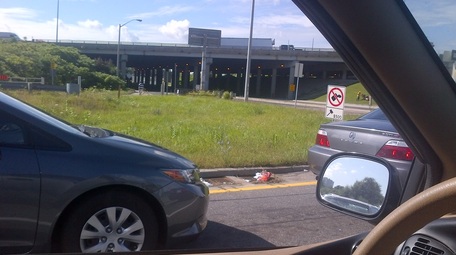I found out all about Rob Ford in 2004 when I took a complaint to the city’s integrity commissioner about Ford, the then renegade councillor and resident council outcast, distinguishing myself as the first Torontonian to do so successfully. I’ve watched Ford like an eagle scout ever since.
Toronto, I believe we have caught him cold committing a crime. Forget the video. Forget the chief of police. Forget the mayor’s criminal friend Mr. Lisi. Erase all that, and you still have the surveillance notes and photos. Within those notes contains the irrefutable record of wrongdoing. An easy guilty plea, iron clad. I’m quoting here from The Toronto Star:
“Police then followed Lisi to what the documents refer to as Weston Wood Park, now called Douglas Ford Park in honour of the mayor’s entrepreneur/politician father. Ford arrived at the park in his Escalade a few minutes later, after which the pair “met and made their way into a secluded area of the adjacent woods where they were obscured from surveillance efforts and stayed for approximately one hour,” according to the documents. The two men emerged from the woods and drove away in their own cars. Police then went into the woods and located the area in the park where Lisi and Ford met, where they found a vodka bottle and a juice bottle, which they seized.”
So there you have it. The Mayor of Toronto, Rob Ford, littered! In a city park, no less! In Toronto the fine for littering is $365. (Earlier in the stakeout the police had observed Ford using a street bin for other bottles and a bag of fast food waste.)
That the mayor has littered would fascinate green criminologists like UK Professor Nic Groombridge. He would tell you that people who litter signal their potential to harbor deeper anti-social problems that can lead them further into crime. In fact, Groombridge has determined that littering is the “gateway crime” just as marijuana has been described as the gateway drug on the road to, say, crack cocaine use.
From littering also comes graffiti, spitting, vandalism, decreasing property values and added costs to the taxpayer. Littering often occurs away from public view.
So when I hear the mayor of Toronto sweating out an apology for us all in the sterility of a midtown radio station, I’d like him to own up and pay up on the littering part of this whole mess at least. People who love clean cities need role models with the capacity to understand why setting an example is important, why not littering is important.
Then there’s the matter of his pissing in a public park ...
Let’s not go there.



 RSS Feed
RSS Feed